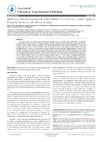Please use this identifier to cite or link to this item:
https://accedacris.ulpgc.es/jspui/handle/10553/74665
| Title: | Molecular characterization of Culex Theileri from Canary Islands, Spain, a potential vector of Dirofilaria Immitis | Authors: | Morchón, R. Bargues, M. D. Latorre-Estivalis, J. M. Pou-Barreto, C. Melero-Alcibar, R. Moreno, M. Valladares, B. Molina, R. Montoya Alonso, José Alberto Mas-Coma, S. Simón, F. |
UNESCO Clasification: | 310907 Patología | Keywords: | Dirofilaria immitis Culex theileri Canary Islands Spain 18S rRNA gene, et al |
Issue Date: | 2011 | Journal: | Journal of Clinical & Experimental Pathology | Abstract: | Dirofilaria immitis is the causal agent of heartworm diseases and of human pulmonary dirofilariosis. The infection is transmitted by several species of culicid mosquitoes that are frequently able to bite both animal reservoirs and humans. Canary Islands (Spain) constitute a well documented endemic area of canine dirofilariosis in which the mosquito species involved in the transmission of D. immitis are not known. The objectives of the present work were the identification of vectors of this parasite in Canary Islands and their molecular characterization. A total of 1219 female mosquitoes were captured. The most abundant species was Culex theileri (52.26%) followed by Cx. pipiens (35.44%), Anopheles cinereus hispaniola (6.23%), Culiseta longiareolata (5.74%), and Culex laticintus (0.33%). PCR was applied for the detection of larval D. immitis DNA in mosquitoes. D. immitis DNA was observed in the abdomen of one Cx. theileri female: 0.082% of the entire mosquito population and 0.17% in Cx. theileri. A molecular identification of Cx. theileri, the potential mosquito vector of dirofilariosis in this zoonotic focus in Canary Islands of Spain, has been made for first time based on sequences of the 18S rRNA gene, the second internal transcribed spacer (ITS2) of ribosomal DNA and the barcode region of the cytochrome c oxidase I (cox1) gene of mitochondrial DNA, allowing a broad mosquito molecular basis for future populations genetic analyses of this vector species. Parasitological and entomological molecular results suggest that Cx. theileri is a potential natural vector of D. immitis in Canary Islands. | URI: | https://accedacris.ulpgc.es/handle/10553/74665 | ISSN: | 2161-0681 | DOI: | 10.4172/2161-0681.S3-001 | Source: | Journal of Clinical & Experimental Pathology [ISSN 2161-0681], S3: 001 (2011) |
| Appears in Collections: | Artículos |
Page view(s)
293
checked on Jul 12, 2025
Download(s)
458
checked on Jul 12, 2025
Google ScholarTM
Check
Altmetric
Share
Export metadata
Items in accedaCRIS are protected by copyright, with all rights reserved, unless otherwise indicated.
